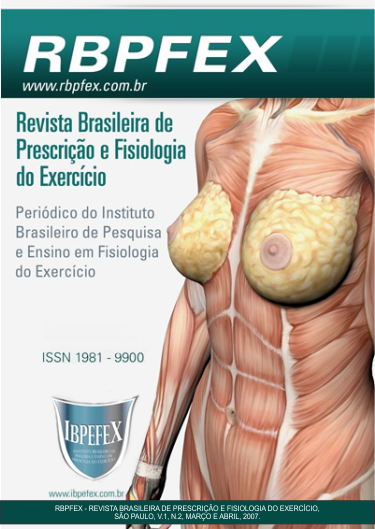Influence of the feeding in the lipodystrophy in carriers of HIV-AIDS practitioners of regular physical activity
Abstract
This work had as objective to evaluate the influence of the feeding in the lipodystrophy, in carriers of HIV-AIDS, practitioners of regular physical activity. Material and Methods: 53 patients had been selected of the ambulatory attendance, these distributed in two groups: Group 1 - masculine sex (n=32); e Group 2 – female (n=21). The patients who had adhered to the dietary treatment (n=35; Group 1=23 and Group 2=12) had been evaluated, before and after 150 days of intermittent nutritional accompaniment, in relation to the measures of weight, cutaneous height, folds, circumferences and relation waist hip and counting of lymphocytes T CD4+. The results had demonstrated to significant increase of referring 3% the lean mass and an increase of 35% in the counting of plasmatic lymphocytes T CD4+ in Group 1. These results suggest that the dietary intervention associate to practices of physical activity exerted expressive modulator effect on the parameters evaluated in relation to the lipodystrophy and the distribution of corporal fat.
References
- Barbosa, R.M.R.; Fornés, N.S. Avaliação nutricional em pacientes infectados pelo Vírus da Imunodeficiência Adquirida. Revista de nutrição de campinas; 2003: 16(4):461-470.
- Bartlett, J.G. New guidelines for antiretroviral therapy from the IAS--USA and DHHS.Hopkins HIV Rep. 2000;12(3): 6-7.
- Carpentier, A.; e colaboradores. Mecanism of Highly Active Antiretroviral Therapy – Induced Hiperlipidemia in HIV – Infected Individuals. Atherosclerosis. 2005; 178(1) 165-172.
- Escott-Stump, S.E. Nutrição Relacionada ao Diagnóstico e Tratamento; 4ª ed. São Paulo: Manole 1999; 760 p.
- Garg, A. Lipodystrophies. American Journal of Medicine. 2000; 108: 143-152.
- Lemos, K.R.V.; Valente, J.G.A. Declaração de óbito como indicador de sub-registro de casos de Aids. Cadernos de Saúde Pública. 2001; 17(3): 617-626.
- Moyle, G.J.; Lloyd, M.; Reynolds, B.; Baldwin, C.; Mandalia, S. e Gazzard, B.G. Dietary advice with or without pravastatin for the management of hypercholesterolaemia associated with protease inhibitor therapy. AIDS, Aug 2001; 15(12): 1503-8.
- Tershakovec, A.M. HIV-Related Lipodystrophy and related factors. Atherosclerosis. 2004; 174: 1-10.
-Szwarcwald, C.L.; e colaboradores. Healthconditions and residential concentration of poverty: a study in Rio de Janeiro, BrazilJ. Epidemiol. Community Health. 2000; 54: 530-536.
Authors who publish in this journal agree to the following terms:
- Authors retain the copyright and grant the journal the right of first publication, with work simultaneously licensed under the Creative Commons Attribution License BY-NC which allows the sharing of the work with acknowledgment of the authorship of the work and initial publication in this journal.
- Authors are authorized to enter into additional contracts separately for non-exclusive distribution of the version of the work published in this journal (eg, publishing in institutional repository or book chapter), with acknowledgment of authorship and initial publication in this journal.
- Authors are allowed and encouraged to post and distribute their work online (eg, in institutional repositories or on their personal page) at any point before or during the editorial process, as this can bring about productive change as well as increase impact and impact. citation of published work (See The Effect of Free Access).






